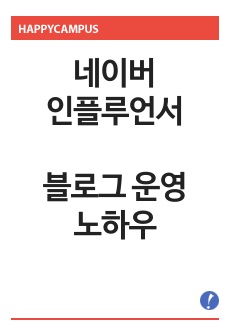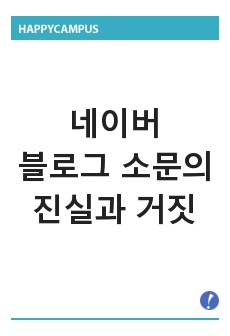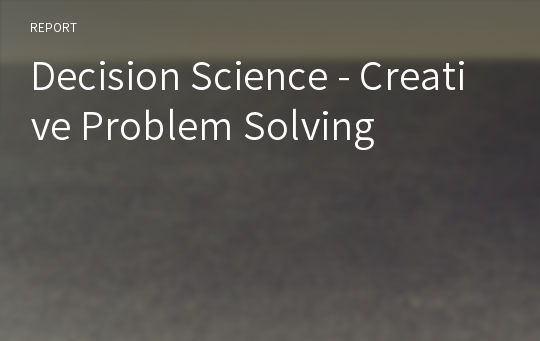Decision Science - Creative Problem Solving
*상*
다운로드
장바구니
소개글
Decision Science영국 대학교 학사 영문 논문으로 분량은 약 14000자 정도이며 Decision Science의 각종이론을 종합하여 비교분석한 좋은점수를 받은 논문입니다. 해당분야 공부하시는분들 많은도움이 되시길 바랍니다.
목차
AbstractIntroduction
The Purpose of the Study
The Background of the Study
The Rationale of the Study
The Alternatives Attainable And Present In The Decision Situation
Decision Aiding
Decision Aiding Techniques and Computer Algorithms
Decision Science Approaches Based on Management
A Comparison of Linear Programming Software on Microcomputers
The Process of Decision Making in Decision Science
The Interaction Problem And Interactive Computer Program
Quality Criteria For Decision-Aiding Technologies
Decision-Analytic Quality
Attitudinal Effects
General and Indirect Effects
User/ System Interaction
Flexibility
Economy/Efficacy
Direct And Indirect Causes And Effects
Designing Evaluation Research
Knowledge From Evaluation Studies
Types of Evaluation
Are DAS Actually Used?
Are DAS Useful?
Analysis and Discussion of Decision Science
Process Components And Problem Taxonomy
Variations in Problem Structuring
Variations in Option Evaluation
Variations in (Social) Context
Levels And Modes Of Decision Making
Conclusions: Perspectives For Future Research
Appendices
References
본문내용
Decision ScienceAbstract
Planning may be explicit or implicit and unconscious and includes determining the level at which a decision should be made, the goals to be attained in the situation, and the strategy for reaching those goals. (Botten, 1999) All of these components of planning are interrelated and determine in part what decision rules and restructuring will be used in the processing of the information about the decision alternatives. The level at which a decision problem is addressed may be determined by such factors as experience with the situation, judged importance, difficulty of situation, and resources available. However, the classification of a decision problem should not be regarded as invariably fixed. Instead, it may be continuously changing because decisions are made in a changing world and because the process of solving a decision problem involves continuous restructuring and reappraisal, both before and after the decision has been made. To a great extent, decision making is a process contingent on the particular information just processed but within the general frames provided by the value system and the goals evoked before a particular problem was presented. (Abelson, 1985) Search for information follows planning. As the arrow going back to planning indicates, the way in which search is performed also depends on how the information is displayed. When, for example, the information is organized either by attribute or alternative, subjects sometimes change their processing accordingly and sometimes they do not.
참고 자료
Abelson, R. &Levi, A. (1985). Decision making and decision theory. In G.Lindzey & E. ronson (Eds.) Handbook of social psychology: 1, 231-309.Aschenbrenner K. M., D. Albert, and F. Schmalhofer. (2004). "Stochastic choice hennistics". Acta Psychologica, 45, 7-34.
Beach, L., & Mitchell, T. (1978). A contingency model for selection of decision strategies. Academy Management Review: 3, 439-449.
Bennis, W., & Naus, B. (1985). Leaders: The strategies for taking charge. New York: Harper & Row.
Betsch, T., Haberstroh, S., Hohle, C. (2002). Explaining routinized decision making: A review of theories. Theory and Psychology, 12 (4), 453-488.
Betsch, T., Haberstroh, S., Molter, B., & Glockner, A. (2004). Oops-I did it again: when prior knowledge overrules intentions. Organizational Behavior and Human Decision Processes, 93, 62-74.
Blau, P. & Scott, R. (2003). Formal Organizations: A Comparative Approach. Stanford, CA: Stanford University Press.
Botten, N., McManus, J. (1999), "“Competitive strategies for service organisations – the role of information technology in business”", pp.16–21.
Bronner F., and R. de Hoog. ( 2004). Non-expert use of a computerized decision aid. In P. Humphreys, O. Sevenson and A. Vari (eds.), Analyzing and aiding decision processes (pp. 281-299). Amsterdam: North-Holland.
Cairo P. C. ( 1999). Evaluating the effects of computer-assisted counseling systems. Counseling Psychologist, 11, 55-59.
Chomsky, N. (1959). Review of Skinner`s Verbal behavior, Language, 35, 26-58. Elman, J. (1990) Finding structure in time. Cognitive Science, 14, 179-212.
Durand, R. & Calori, R. (2006). Sameness, Otherness? Enriching Organizational Change Theories with Philosophical Considerations on the Same and the Other. Academy of Management Review, 31: 93-114.
Fischhoff B. ( 2001). Decision analysis: Clinical art or clinical science? In L. Sjöberg , T. Tyska, and J. A. Wise (eds.), Decision analysis and decision processes (pp. 68-94). Lund: Doxa.
Goldstein, M., & Gigerenzer, G. (2002). Models of ecological rationality: The recognition heuristic. Psychological Review, 109, 79-90.
Govindararajan, V., & Trimble, C. (2006). Achieving breakthrough growth: From idea to execution. Ivey Business Journal, 70, 1-7.
Harrison, K. (2005). Focus on customers and core values. Industry Week, 13, 14-16.
Immettt, J. (2006). Innovation Imperative. Leadership Excellence, 23, 16-17.
James, W. (1890). The principles of psychology. New York: Dover.
Janis, I., Mann, L. (1977) Decision making: a psychological analysis of conflict, choice, and commitment. New York: The Free Press.
Jennings D., and S. Wattam, Decision Making: An Integrated Approach, Pitman Pub., Financial Times, and Prentice Hall, 1998.
Jones, G. & Janson, H. (2004). Organizational Theory, Design, and Change (4th ed). Upper Saddle River, NJ: Pearson Prentice Hall.
Jones, T., & Ryan, L. (1997). The link between ethical judgment and action in organizations: A moral approbation model. Organizational Science, 8: 663-680.
Jungermann H., H. -R. Pfister, and R. S. May. ( 2001). Competing motivations or changing choices: Conjectures and some data on choice-action consistency. In J. Kuhl and J. Beckmann (eds.), Volition and personality. Göttingen: Hogrefe.
Kerfoot, K. (2006). The Johnny Appleseeds of Organizational Change. Dermatology Nursing, 18, 208-210.
Kleindorfer, P., Kunreuther, H., & Schoemaker, P. (1993). Decision Science, An Integrated Perspective. New York: Cambridge University Press.
Kotter, J. (2006) Transformation. Leadership Excellence, 23, 1-14.
Lipshitz, R., Klein, G., Orazanu, J., Salas, E. (2001) Taking stock of naturalistic ` decision making. Journal of Behavioral Decision Making, 14, 331-352.
McGuire, D., & Hutchings, K. (2006). A Machiavellian analysis of organizational change. Organizational Change, 19: 192-209.
McKenzie, C., Lee, S.,Chen, K. (2002). When negative evidence increases confidence: Change in belief after hearing two sides of a dispute. Journal of Behavioral Decision Making, 15, 1-18.
Mohanty, R., & Deshmukh, S. 2002. Reengineering of materials management system: A case study. International Journal of Production Economics, 70, 267-278.
Montgomery H. 2000. The search for a dominance structure: Simplification and elaboration in decision making. In D. Vickens and P. L. Smith (eds.), Human information processing: Measures, mechanisms and models. Amsterdam: North-Holland.
Nagel S. ( 2000). Decision-aiding software for all fields of knowledge. International Journal of Information Management, 8, 123-140.
Rooke, D. & William, R. (2005) 7 transformations of leadership. Harvard Business Review, 83, 66-78.
Sanna, L., Schwarz, N. & Stocker, S. (2002) When debiasing backfires: Accessible content and accessibility experience in debiasing hindsight. Journal of Experimental Psychology: Learning, Memory, and Cognition, 28, 497-502.
Sharda R., S. H. Barr, and J. C. Mcdonnell. ( 2003). Decision support system effectiveness. A review and an empirical test. Management Science, 34, 139-159.
Sparrow, S. (2005). But others still suffer from a leadership deficit. Training Magazine, 5, 1-6.
Storseth, F. (2004). Maintaining Work motivation during organizational change. International Journal of Human Resource Development & Management, 4, 267-287.
Strebel, P., & Ohlsson, A. (2006). The Art of Making Smart Big Moves. MIT Sloan Management Review, 47, 79-93.
Streitz N. A. ( 2001). Cognitive ergonomics: An approach for the design of user oriented interactive systems. In F. Klix and H. Wandke (eds.), Man-computer interaction research (pp. 21-33). Amsterdam: North-Holland.
Thomas, C. & Lawler, E. (2006). Built to Change. Leadership Excellence, 23, 1-4.
Thomas, S. (2005). Architects of Change. Harvard Business Review, 84, 1-10.
Wirtenberg, J., Abrams, L., & Ott, C. (2004). Assessing the field of organizational development. Journal of Applied Behavioral Science, 4, 465-479.
Tyszka T. (2003). Contextual multiattribute decision rules. In L. Sjöberg, T. Tyszka and J. A. Wise (eds.), Human decision making. Lund, Sweden: Doxa.
van F. D. J. Schaik, and H. G. Sol ( 2000). Effectiveness of decision support systems. Proceedings of the 23d Annual Hawaii International Conference on System Science (3:50-58). Los Anamitos, CA: IEEE Computer Society Press.
Vlek C., D. Timmermans, and W. Otten. The idea of decision support.
Wooler S. ( 2002). Decision aid for structuring and evaluating career choice options. Journal of Operational Research Society, 33, 343-353.
Zachary W. ( 2002). A cognitively based functional taxonomy of decision support techniques. Human-Computer Interaction, 2, 25-63.






















